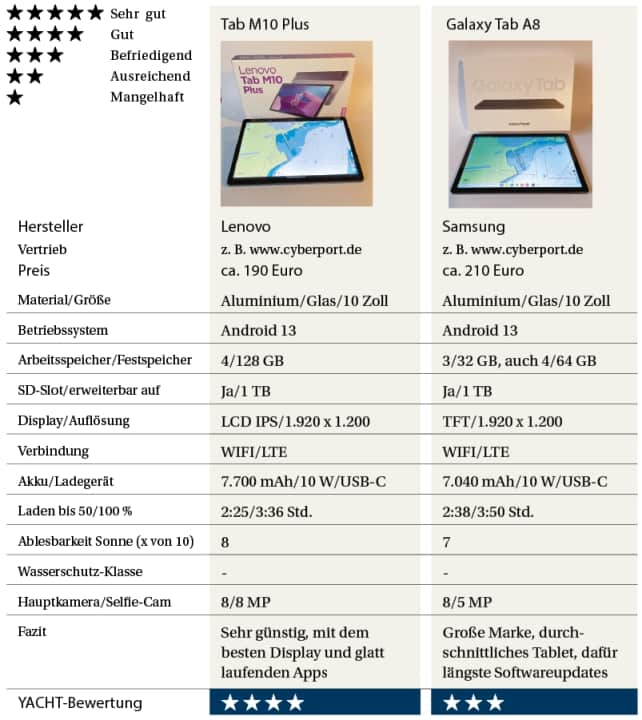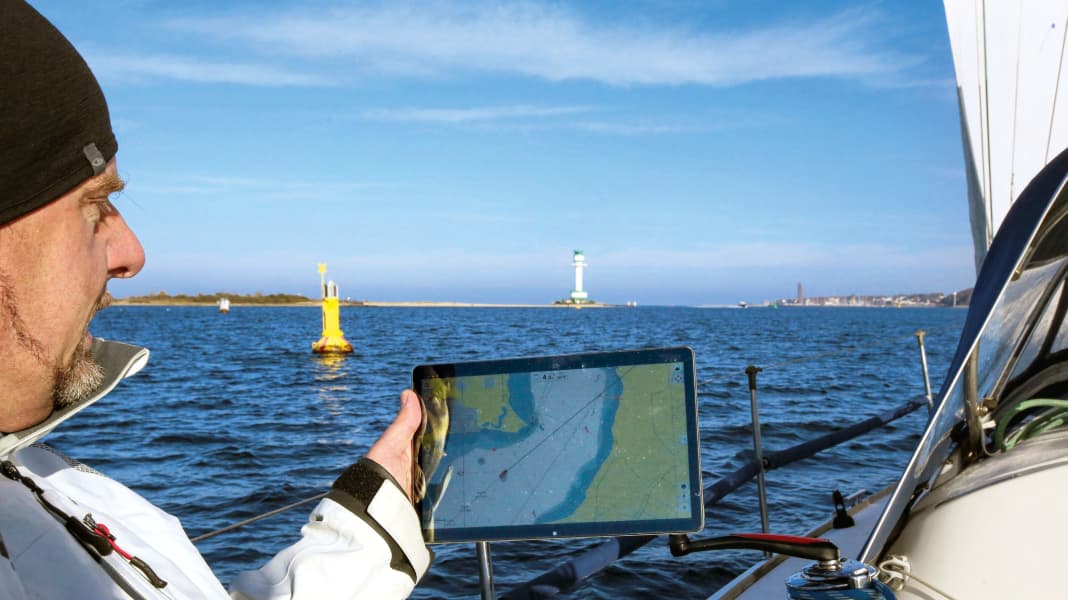
- A lot is happening in terms of tablet hardware
- The software of the tablets remained undemanding
- Three affordable tablets in the test
- Keep your eyes open when buying a tablet!
- How much computing power do the tablets need?
- Only Android as the operating system for the tablets
- None of the common sat nav apps work with Huawei
- How long and how brightly do the tablet displays light up?
- How long do the tablets take to charge?
- The necessary accessories for the tablets
- Buying a budget tablet requires more care than buying a top-end device.
- The data of the two apps in detail:
Special tablet navigation
- How low-budget devices fare against products from Apple and Samsung, where the weaknesses lie
- Why the new Orca system from Norway can be an alternative to plotters and good tablets
- Which innovations and tools make the current TZ-iBoat app a challenger to Navionics
On-board navigation via app has been on the rise for years. Owners use them as an alternative or supplement to a plotter, while charter crews have their familiar device in their luggage. The advantages are obvious: you can use the system anywhere in the cockpit or below deck, you don't have to get used to a new chart image or different settings and you know exactly when the chart set was last updated. In the latest YACHT reader survey, over 60 per cent of respondents stated that they use sat nav apps.
YACHT tested the programmes for their features from time to time.
The editorial team mostly used top test hardware from Apple and Samsung's S series, as these are the best-selling brands on the tablet market and the app manufacturers often optimise the functioning of the apps for them. However, the top devices also have a disadvantage: prices have been rising sharply for years. The cheapest 10-inch model from Apple with a GPS chip (these are only the "Wifi & Cellular" models) is currently available from just under €780, the Air model is almost €1,000 and the Pro version starts at €1,250. Samsung's cheapest top tablet, the S9, is around 870 euros, while the somewhat simpler S9 FE is still over 600 euros. Proud prices then. If your budget is small or you rarely use tablets at home, inexpensive models that often only cost around 150 to 230 euros are tempting.
So far, the editorial team has always recommended the top devices in terms of hardware because the software ran smoothly, GPS positions were very accurate and there were almost no crashes. The reasons were simple: the models have enough processor speed and plenty of RAM to avoid stutters. In addition, the displays are bright and sharp enough in sunlight because only the best of the best is usually used.
A lot is happening in terms of tablet hardware
Since then, however, there has been a two-pronged development: tablets have improved at a rapid pace. Faster processors, four, six or even eight gigabytes of RAM instead of one or two, and better, brighter displays. The latter were the most common annoyance with budget models: the cheaper LCD versions were almost impossible to read in direct sunlight and were very reflective.
The software of the tablets remained undemanding
The sat nav apps, on the other hand, remained rather similar in terms of memory requirements and processor speed. After all, there are no complex graphical refinements, and although many features have been added over the years, nothing has brought performance to its knees. The development of GPS chips in recent years has also increased the accuracy and reliability of positions, partly because user data has become increasingly important for various services used.
Dedicated marine devices with external, often much larger antennas are still superior in terms of accuracy.
But the question is whether this plays a role. Many members of the editorial team have been using sat nav apps on tablets or smartphones for years, usually as a supplement to the on-board systems. It was many years ago that a colleague reported significant positioning errors. What's more, if a GPS plotter is installed on board, anyone can check their device for deviations at the beginning. What's more, the data from on-board GPS devices can also be integrated into many sat nav apps via Wi-Fi.
Three affordable tablets in the test
Reason enough for the editorial team to try out three affordable tablets from major manufacturers for mobile navigation. These are the Samsung Galaxy Tab A8, the Lenovo Tab M10 Plus and the Redmi Pad SE.
The first tangible surprise comes when unpacking: Whereas budget tablets often used to look and feel like cheap plastic devices, the three test candidates offer an almost dignified finish: high-quality looking and feeling aluminium/glass casing, narrower frames between the display and the outer edge instead of thick black bars as in the past, which downgraded the nominal ten-inch tablet to nine inches.
The second, but this time very unpleasant surprise is experienced when installing the navigation apps via the Google Play app store: The Redmi Pad SE installs apps such as Navionics Boating or C-Map, but refuses to install the NV app, stating that the device is not suitable for this. A little research reveals an unexpected problem:
Keep your eyes open when buying a tablet!
For the test, the editorial team selected one device from the dozens of available models from all possible manufacturers that proved to be unsuitable after delivery and installation of the software: The Redmi Pad SE from the Chinese company Xiaomi did not have a GPS chip installed at all, contrary to the information provided by the online retailer that had it on offer.
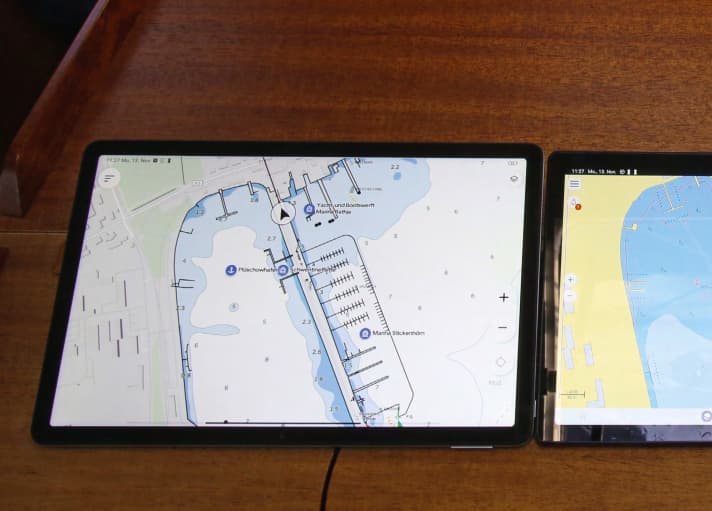
A check of the manufacturer's website revealed that the chip is not explicitly mentioned in the technical specifications. Conversely, this means that it is not on board. Such negligence on the part of dealers is not uncommon, as a look at other offers revealed. Tip: Be sure to check the manufacturer's website, if no GPS chip is listed, don't buy the device!
Does it have a GPS chip or not?
The device does not have a GPS chip, although it was listed in the seller's technical specifications! A search on the manufacturer's website only reveals that a GPS chip is not explicitly mentioned as being present. Finally, under "Location" in the operating system, there is a small note stating that the device does not support satellite navigation, but only triangulates via radio masts, as the cheaper iPads only do.
This becomes apparent during the test run with the Navionics app: the nautical chart shows the position of our boat, but it is a good 150 metres off and also moves by 100 or 200 metres, even though we are sitting in the cockpit.
This makes the tablet unsuitable for navigation, even if you could theoretically still use it by utilising the on-board GPS data via Wi-Fi. But: That's probably why nobody buys a tablet for navigation.
How much computing power do the tablets need?
That leaves the Samsung and Lenovo devices. The installation of the Navionics Boating, NV-Charts, C-Map and Garmin Active Captain software works smoothly on both. When the app is started up, the berth position of the test yacht in Kiel's Stickenhörn harbour is immediately displayed to the nearest metre. What is then noticeable, however, is that if you scroll the map image in the NV app with the Samsung Galaxy Tab A8, grey bars without data remain for a second before the image is reloaded. However, this does not affect the function.
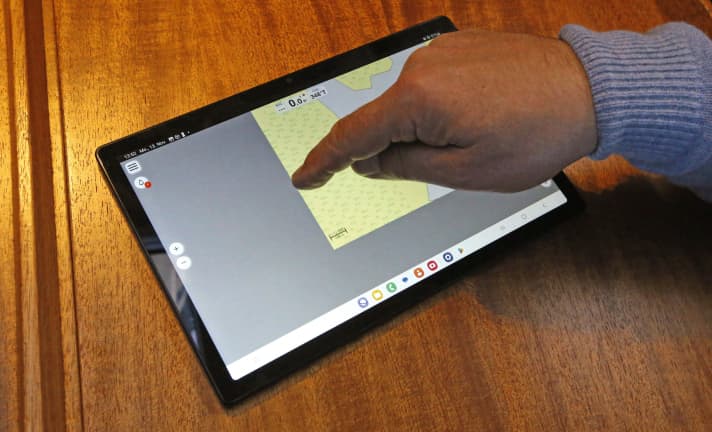
With the Navionics app, however, it runs smoothly and without any problems. We know from testing experience and also from the manufacturer NV-Verlag that the application requires a relatively large amount of RAM. With top devices that have four gigabytes or more, this is not a problem at all, but the Samsung only has three in the tested version. However, a larger, more expensive version with four gigabytes is available. So if you plan to use the NV app later, you should buy the Galaxy with at least four gigabytes of RAM or choose an app that works well with less, such as the one from market leader Navionics.
The Lenovo pad has four gigabytes, and all of the software we tested runs perfectly smoothly.
We cast off. Both GPS positions move out immediately with the first movement of the boat, the sensitivity of the GPS chip is already correct. But despite the cursor moving correctly on the Lenovo tablet, the direction of travel is displayed incorrectly for a few seconds with the arrowhead. The position of the ship is correct, but the cursor is positioned as if we were travelling backwards. Strangely enough, the problem no longer occurred later when the boat was actually always moving slightly. Changes of direction were displayed without errors, the position did not jump and was exactly correct in the narrow passage of fixed buoys and the Friedrichsort beacon. In our test, in which we repeatedly passed fixed landmarks such as harbour entrances, sounding marks and a beacon, neither device had any problems with the position indication, the cursor moved smoothly, there were no jumps or dropouts.
After half an hour on the water, the sun comes out as hoped, which is important to see how the display performs in daylight brightness. Both of our budget tablets have cheaper LCD or TFT displays, not state-of-the-art OLED versions like many high-end devices. However, there are now also some technologies in the LCD sector that can lead to very different, but also very good display quality.
In the auto function for brightness control, both tablets appear to us to be too dark for on-board use, but this is sometimes also the case with more expensive models. The brightness must then be manually adjusted upwards via the operating system. We do this and set it to the maximum level.
The brighter of the two candidates is clearly the Lenovo, whose display is brighter and easier to read. The tablet is less reflective than the Samsung, even when the light is unfavourable. But of course this is one of the strengths of a tablet in the cockpit: you can always hold it in such a way that it offers ideal brightness, as it is not permanently mounted on a bracket. But if that's exactly what you want to do, the Lenovo is clearly the better choice.
Only Android as the operating system for the tablets
If you buy budget tablets, you inevitably have to accept Android as the operating system. The sat nav apps are available from almost all providers for Android, the only exception being TZ iBoat from Nobeltec/Maxsea.
- to test the TZ iBoat software
None of the common sat nav apps work with Huawei
Beware of Huawei devices that are not allowed to use Android due to a US embargo and instead have a Chinese operating system. None of the common sat nav apps will work with them. A weak point of Android is that many hardware manufacturers, especially those of cheaper devices, usually only offer two to three Android version updates and then one, maximum two years of security updates. Lenovo and Redmi do not generally comment on this, while Samsung promises three major updates for A-tablets, usually followed by around one year of security updates. The top devices have an advantage here: Apple and Samsung's S series offer a minimum of five years.
How long and how brightly do the tablet displays light up?
The next important question is how long the devices' batteries last at maximum brightness. We use them in the same way as we would on board: The app is running the whole time, with tracking switched on for the route sailed, even if it is only working in the background. The tablet is used for a regular check of the course and map or sometimes a distance measurement or harbour view, and we let it switch to sleep mode during the breaks in between so that the display goes dark. How quickly this happens, whether after a few seconds or later, can be set via the operating systems. Used in this way, both devices were still at around 50 per cent battery power after around 3.5 hours of use. After five hours, you reach the point where it is better to recharge the battery to make sure you still have enough power for harbour navigation.
How long do the tablets take to charge?
Back in the harbour, we connect the two tablets to the 220 V chargers with the new EU standard USB-C connection. Unfortunately, with ten watts of power, they are very weak. A concession made by the manufacturer to the price, which is unfortunately becoming increasingly common even in the top price range.
Two hours, 25 minutes to 50 per cent and 3:36 to full charge for the Lenovo and 2:38 and 3:50 hours for the Samsung are not exactly fast. However, the latter can also handle a 15-watt charger, the Lenovo even 20 watts. The faster devices and cables have to be purchased separately and cost around 13 to 25 euros, depending on the retailer. Or you can find something suitable in the general accessories trade or even in the chargers with USB-C connection that are usually lying around at home. This should result in significantly faster charging times.
A few words about the non-sailing-specific features of the tablets: It is nice that both still have the classic jack connection for headphones, for which everyone probably still has headphones lying around. They are not included in the scope of delivery in this price range. If you like, you can also expand the memory with a micro SD card, both can then hold up to one terabyte. This creates plenty of space for streamed films or your own music. The two models tested have a main camera and a selfie camera, the former with eight gigabytes. These can be used to take photos for the app's logbook function, for example - but otherwise the image quality is rather mediocre. Back in the harbour, it's time for a conclusion.
The necessary accessories for the tablets
A shockproof cover is an indispensable companion for a sat nav tablet to protect it from falling. Somewhat more expensive models already have retaining tabs on the back, a stand and are splash-proof. You shouldn't expect devices in this price range to be waterproof, but even many iPads and top Samsung devices are only splashproof against fresh water. Protective covers for budget tablets are inexpensive, often starting at 16 to 25 euros (plus shipping). However, they are not waterproof as the charging ports remain open.
This is why many people charge the device at a USB socket below deck in between uses. Make sure that it charges with at least 10 watts or better. A simple and practical alternative: buy a larger power bank. Models with more than 10,000 to 20,000 mAh easily fill the test tablets completely and cost 20 to 40 euros. Combined with a waterproof foil bag cover, the device can then be charged in the cockpit - such solutions are more common among small boat sailors. The ones from Aquapac, for example, are good, starting at around 50 euros.
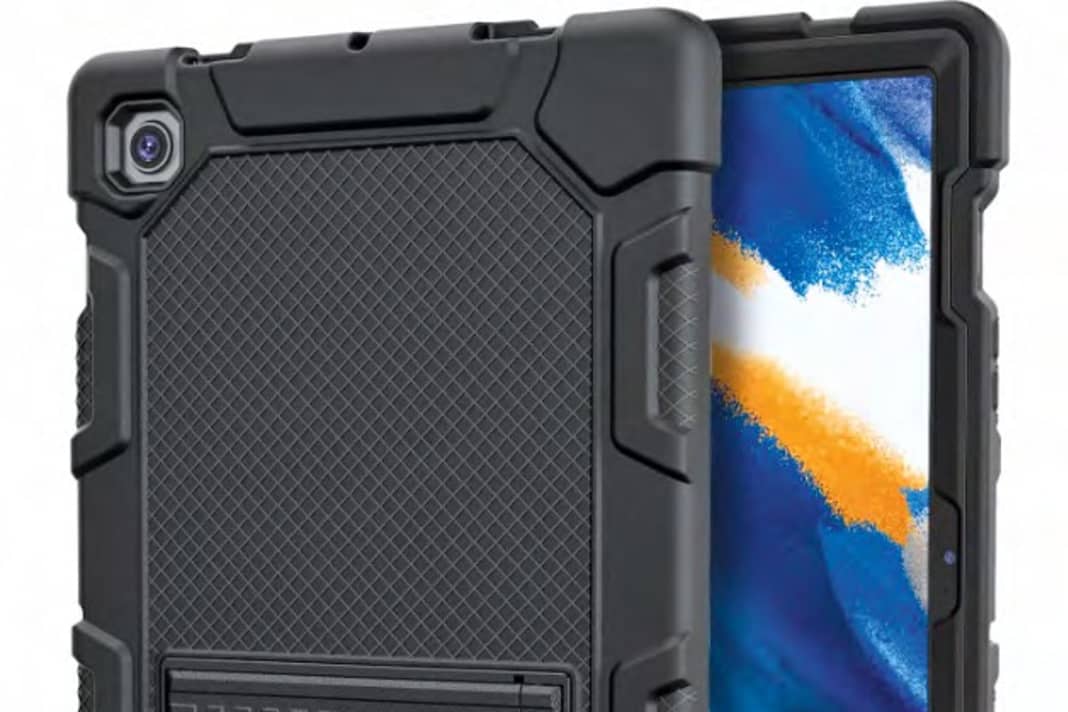


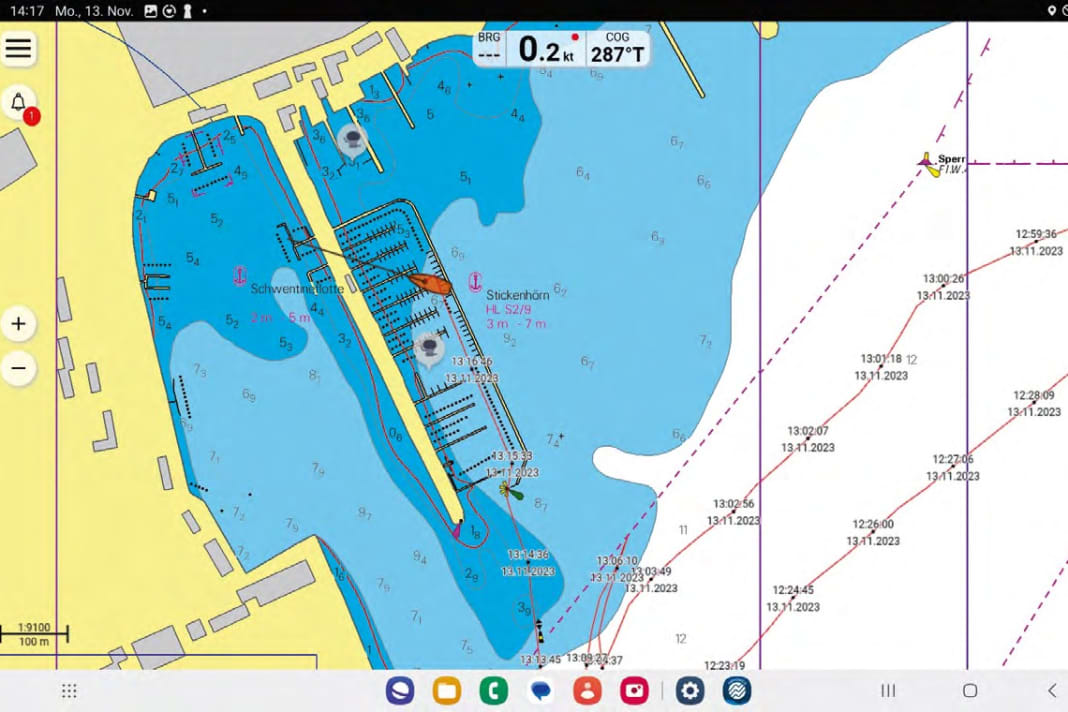


Buying a budget tablet requires more care than buying a top-end device.
- It is best to check the technical data on the manufacturer's website beforehand to make sure that a GPS chip is installed and not to rely on information provided by intermediaries when shopping online.
- Four gigabytes of RAM should be installed to ensure that all common apps run smoothly. Otherwise, the budget tablets fulfil their purpose, albeit with slight compromises in terms of screen brightness and - depending on the manufacturer - the duration of software updates.
- But the price of only around a quarter of a top Apple or Samsung device has to be explained somehow.
The data of the two apps in detail:
